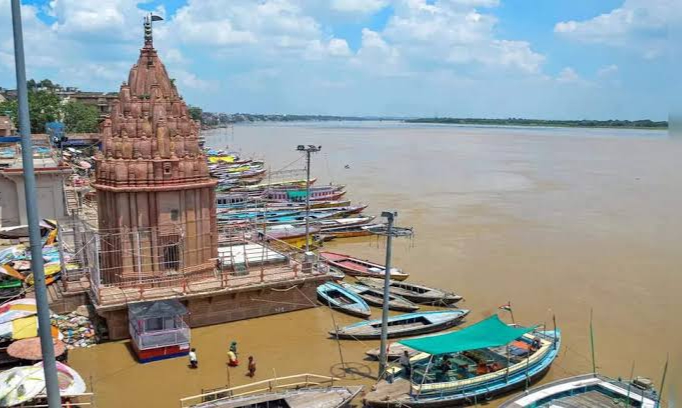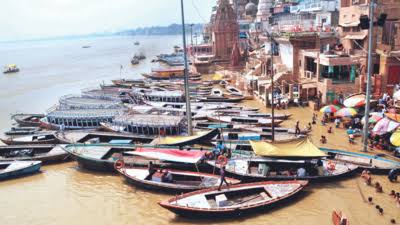In recent weeks, the water levels of the Ganges River in Varanasi have become a cause for concern once again. After several days of declining levels, the river's water has begun to rise steadily, posing a renewed threat to the coastal areas and the people living near the riverbanks. On Friday morning, the water level was recorded to be increasing by two centimeters per hour, raising alarm among the local administration and disaster management teams.
Currently, the Ganges River's water level is about four meters below the warning mark, but with the recent surge, the threat is becoming more imminent. The local administration, along with the National Disaster Response Force (NDRF) and the water police, is on high alert to prevent any potential disasters.

The Warning Signs: Ganga Reaching Critical Levels
Last week, the Ganges River saw a sharp increase in water levels, approaching the warning mark. This surge led to flooding in the coastal areas, submerging ghats, and creating significant hardships for the residents living nearby. Many people had to seek refuge in flood shelters, and the situation became increasingly challenging for those dependent on the river for their daily activities.
The past few days saw a brief respite as the water levels began to recede. However, by Thursday, the situation had stabilized, and by Friday, the water levels started rising again. This has brought back the threat of flooding, raising concerns among the authorities and the local population.
Varanasi's Flood Markers: Understanding the Critical Points
In Varanasi, the warning mark for the Ganges River is set at 70.262 meters, while the danger mark is at 71.262 meters. Currently, the water level is approximately four meters below the warning mark, but the situation remains fluid. The Central Water Commission, NDRF, and the water police are continuously monitoring the river's water levels to ensure timely action.
The authorities are focusing on raising awareness among the local population, particularly those who frequent the ghats. The NDRF has deployed water ambulances and special rescue teams to address any emergencies that may arise due to the rising water levels. The administration is determined to ensure that no loss of life or property occurs as a result of the potential floods.
The Impact of Rising Water Levels on Coastal Areas
The rising water levels of the Ganges River have a direct impact on the coastal areas of Varanasi. As the water level increases, the riverbanks become more susceptible to erosion, leading to the displacement of people living in these areas. Floodwaters can inundate homes, agricultural fields, and infrastructure, causing widespread damage.
For the people living near the river, the situation is particularly dire. Many of them rely on the river for their livelihoods, whether it be fishing, farming, or tourism-related activities. The rising water levels disrupt these activities, leading to economic hardships for the affected families. The flooding also poses health risks, as stagnant water can become a breeding ground for diseases.
The Role of the Administration in Preventing Disasters
In response to the rising water levels, the local administration has taken several measures to mitigate the risks. The Central Water Commission is closely monitoring the situation, providing real-time data to the authorities. The NDRF and water police have been deployed to the most vulnerable areas, ensuring that rescue operations can be carried out swiftly if needed.
The administration has also set up flood shelters in various parts of the city to provide refuge for those displaced by the rising water levels. These shelters are equipped with basic amenities, including food, water, and medical supplies. The authorities are working to ensure that these shelters are ready to accommodate a large number of people if the situation worsens.
Moreover, awareness campaigns have been launched to educate the public about the dangers of rising water levels. People living near the riverbanks are being advised to stay vigilant and evacuate to safer areas if necessary. The administration is also coordinating with local NGOs and community organizations to provide assistance to those in need.
The Historical Context: Floods in Varanasi
Varanasi has a long history of dealing with floods, given its location along the Ganges River. In the past, floods have caused significant damage to the city's infrastructure and affected the lives of thousands of people. The ghats, which are an integral part of Varanasi's cultural and religious identity, are particularly vulnerable to flooding.
One of the most devastating floods in recent history occurred in 1978 when the Ganges River rose to unprecedented levels, submerging large parts of the city. Since then, the authorities have been more proactive in managing the river's water levels, but the threat of floods remains ever-present.
The current situation serves as a reminder of the challenges that Varanasi faces in dealing with the forces of nature. The rising water levels of the Ganges River are a stark reminder of the power of the river and the need for constant vigilance.
The Response of the Local Population
The people of Varanasi are no strangers to the challenges posed by the Ganges River. Over the years, they have developed a resilience that allows them to cope with the periodic floods. However, the rising water levels still bring with them a sense of anxiety and uncertainty.
For many, the Ganges River is not just a source of water but a sacred entity that holds deep religious significance. The ghats, where people gather for religious rituals, are an integral part of life in Varanasi. The rising water levels threaten these rituals, forcing people to adapt to the changing circumstances.
Despite the challenges, the people of Varanasi remain hopeful. They rely on the support of the administration and the community to get through these difficult times. The resilience of the local population is a testament to their strength and determination in the face of adversity.
The Environmental Factors Contributing to Rising Water Levels
The rising water levels of the Ganges River are influenced by several environmental factors. Heavy rainfall in the upstream areas, particularly in the monsoon season, contributes to the increased flow of water into the river. Additionally, the melting of glaciers in the Himalayas, due to climate change, adds to the volume of water in the Ganges.
Deforestation and urbanization in the river's catchment area have also played a role in altering the natural flow of the river. The loss of vegetation reduces the land's ability to absorb water, leading to increased runoff into the river. This, coupled with the construction of dams and embankments, has changed the river's natural course, making it more prone to flooding.
The rising water levels of the Ganges River are a reminder of the delicate balance between nature and human activity. The need for sustainable development and environmental conservation has never been more apparent.
The Way Forward: Long-Term Solutions
While the immediate focus is on preventing a disaster, there is a growing recognition of the need for long-term solutions to address the challenges posed by the rising water levels of the Ganges River. These solutions must take into account both the environmental factors and the needs of the local population.
One approach is to invest in better flood management infrastructure. This includes the construction of more robust embankments, flood barriers, and drainage systems to protect vulnerable areas from flooding. Additionally, there is a need for better urban planning that takes into account the risks of flooding and ensures that new developments are resilient to such events.
Another important aspect is the need for reforestation and conservation efforts in the Ganges River's catchment area. By restoring the natural vegetation, the land's ability to absorb water can be improved, reducing the amount of runoff into the river. This, in turn, can help mitigate the risks of flooding.

Furthermore, there is a need for greater public awareness and community involvement in disaster preparedness. By educating people about the risks of rising water levels and providing them with the tools to protect themselves, the impact of floods can be minimized.
Conclusion: Vigilance and Preparedness Are Key
As the water levels of the Ganges River continue to rise, the threat to the coastal areas of Varanasi remains ever-present. The local administration, along with disaster management teams, is doing everything in its power to prevent a catastrophe. However, the situation serves as a reminder of the importance of vigilance and preparedness in the face of natural disasters.
The people of Varanasi have faced such challenges before and have shown remarkable resilience. With the support of the authorities and the community, they will undoubtedly rise to the occasion once again. However, the long-term solution lies in addressing the root causes of the problem and taking proactive measures to prevent such events from occurring in the future.
The rising water levels of the Ganges River are not just a local issue but a reflection of the broader challenges posed by climate change and environmental degradation. By working together, the people of Varanasi, along with the rest of the world, can ensure that the Ganges River continues to be a source of life and prosperity, rather than a threat.











